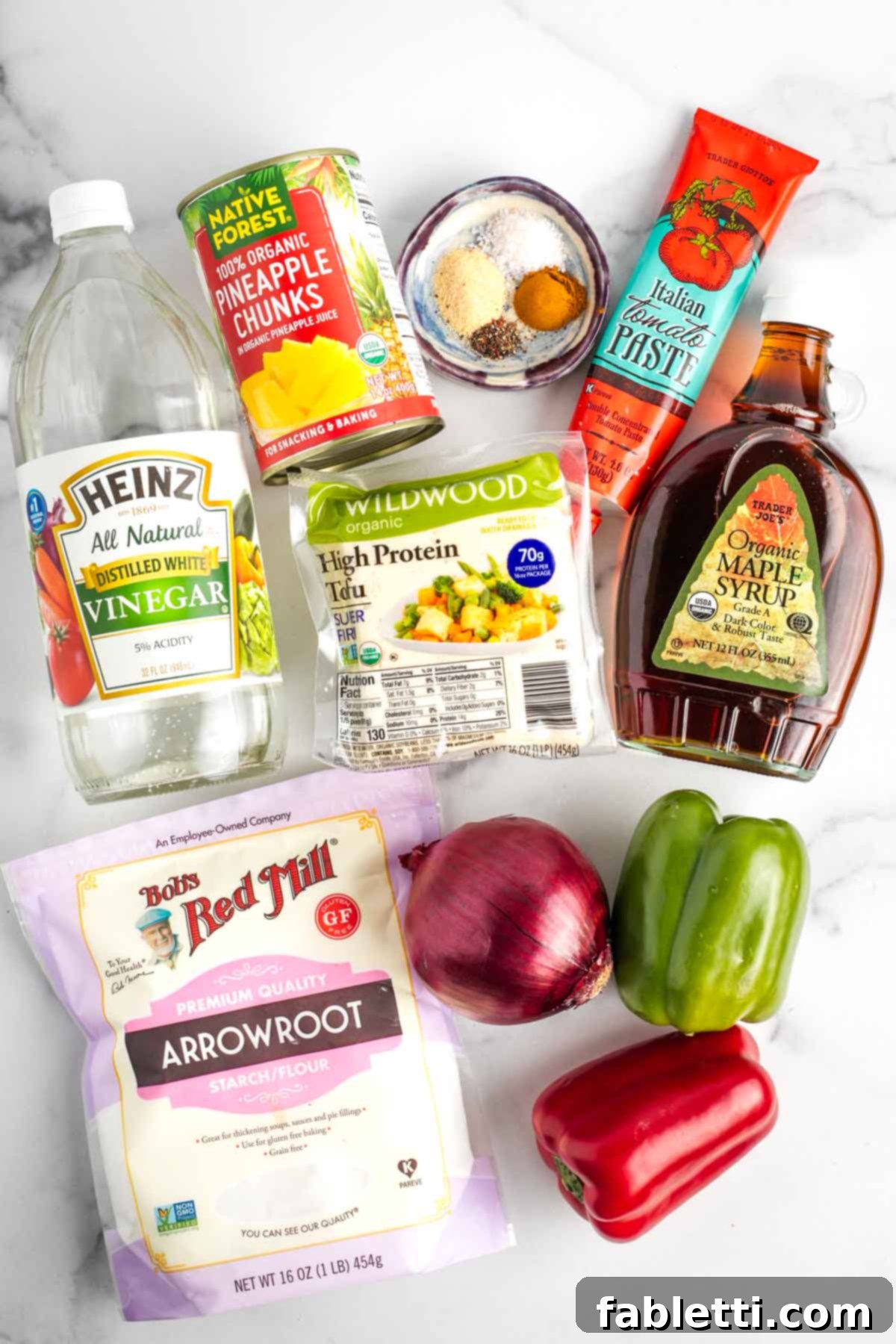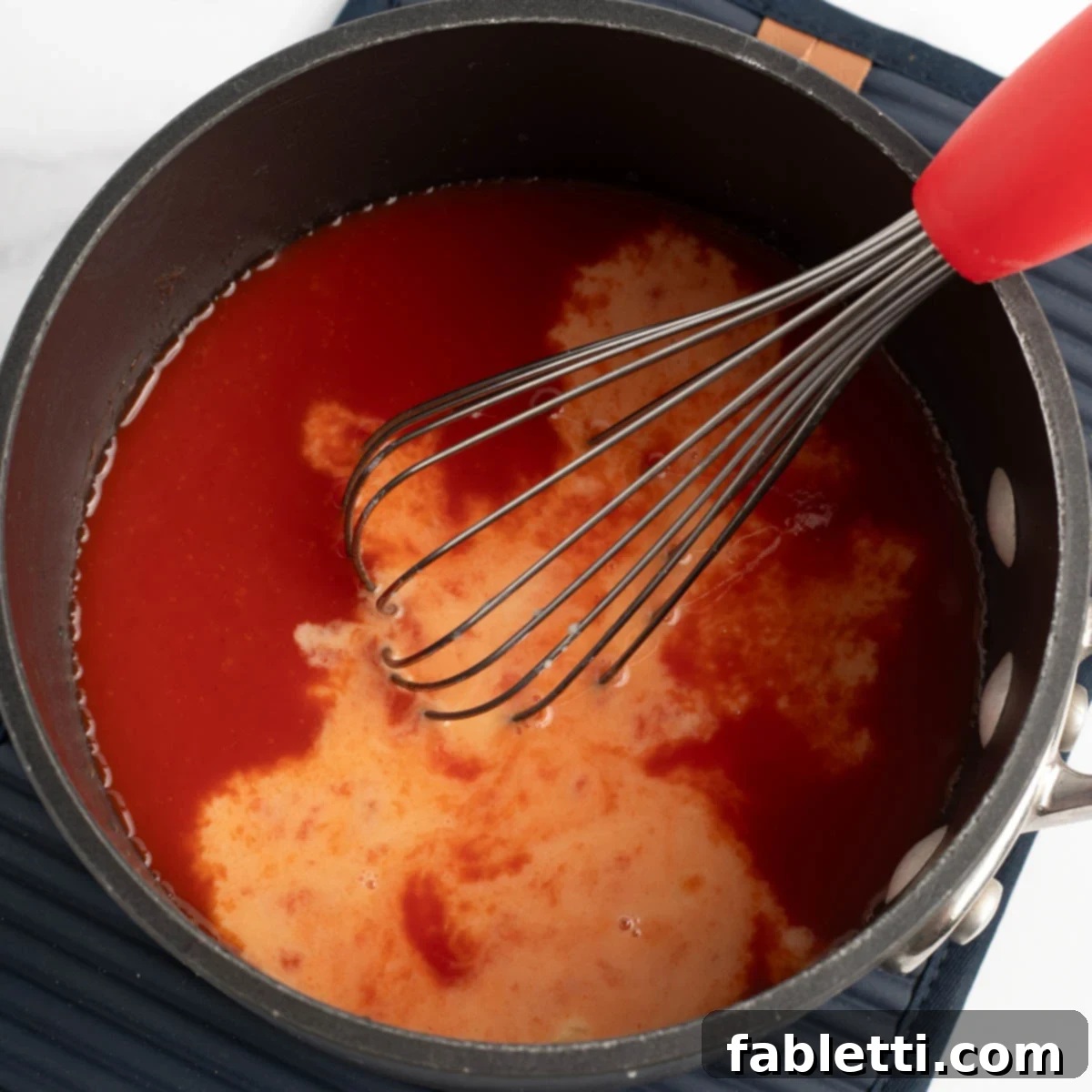Transform your dinner routine with this sensational Sweet and Sour Crispy Tofu – a plant-based, gluten-free masterpiece that effortlessly outshines any takeout order. Imagine perfectly golden, crunchy tofu cubes, vibrant sautéed vegetables, and juicy pineapple pieces, all enveloped in a rich, tangy, and subtly sweet sauce. This dish isn’t just a meal; it’s an experience that proves healthy eating can be incredibly flavorful, satisfying, and quick to prepare.

Say goodbye to long delivery waits and hello to a culinary triumph prepared right in your kitchen! Our Sweet and Sour Tofu recipe delivers on all fronts: it’s incredibly crispy, wonderfully saucy, and packed with irresistible flavor. Best of all, this entire dish comes together in just 30 minutes, using simple pantry staples you likely already have on hand. No more compromises on taste or health when you’re short on time – this recipe offers a delicious, wholesome alternative to traditional takeout, making weeknight dinners exciting and stress-free.
This recipe is more than just a quick meal; it’s a testament to how flavorful and exciting vegan and gluten-free cooking can be. The unique blend of sweet, sour, and savory notes creates a harmonious taste profile that appeals to a wide range of palates. Whether you’re a long-time plant-based eater or simply looking to incorporate more wholesome, homemade meals into your diet, this Sweet and Sour Crispy Tofu is a must-try. It’s a vibrant, satisfying dish that promises to become a regular in your meal rotation.
Essential Ingredients & Smart Substitutions for Your Sweet and Sour Tofu
Crafting the perfect Sweet and Sour Tofu begins with selecting the right ingredients. Each component plays a vital role in achieving the dish’s signature texture and flavor profile. Below, we delve into the key ingredients and offer helpful substitution tips to ensure your meal is both delicious and adaptable to your pantry.

- Tofu: The foundation of our dish, crispy tofu is key! Always opt for firm or extra-firm tofu. These varieties contain less water, making them ideal for pressing and achieving that desired crisp exterior. Softer types like silken or soft tofu will not hold their shape or crisp up properly, resulting in a mushy texture.
- Canned Pineapple: This ingredient pulls double duty! We utilize both the sweet and tangy pineapple chunks for flavor and texture, and the natural pineapple juice forms a crucial base for our vibrant sweet and sour sauce. If you prefer, fresh pineapple can be used for the chunks, but you’ll need to source pineapple juice separately for the sauce.
- Tomato Paste: A concentrated burst of umami and color, tomato paste gives the sauce its rich depth. For the purest flavor and to avoid unnecessary additives, look for a brand that lists only one ingredient: tomatoes. This ensures a clean, natural taste.
- Vegetables: Classic bell peppers (red and green for visual appeal and varied sweetness) and onions are perfect partners for the tofu and pineapple, adding freshness, crunch, and essential nutrients. Feel free to customize with other quick-cooking veggies you love, such as broccoli florets, snap peas, shredded carrots, or mushrooms. This recipe is wonderfully versatile, allowing you to incorporate seasonal produce.
- Arrowroot Powder: Our preferred thickener for the sweet and sour sauce and for coating the tofu. Arrowroot powder provides a silky, clear sauce and a wonderfully crispy coating for the tofu. I choose arrowroot over cornstarch due to concerns about cornstarch being heavily sprayed, often genetically modified, and sometimes processed with filler ingredients. Arrowroot is a fantastic natural, gluten-free alternative that performs beautifully.
- Maple Syrup: This natural sweetener balances the tanginess of the vinegar and pineapple juice in the sauce, providing a rich, complex sweetness. Agave nectar or brown rice syrup can be suitable alternatives if maple syrup is unavailable.
- Distilled White Vinegar: Essential for the “sour” component of our sauce, white vinegar offers a clean, sharp acidity. Rice vinegar is a common substitute in Asian-inspired dishes and would also work well here, offering a slightly milder tang.
- Avocado Oil: With its high smoke point, avocado oil is excellent for pan-frying the tofu to a perfect crisp. Other high smoke point oils like grapeseed oil or refined coconut oil (if you don’t mind a slight coconut flavor) can also be used.
- Spices: Garlic powder, turmeric, sea salt, and black pepper enhance the flavor profile of the tofu coating, adding aromatic notes and a hint of warmth from the turmeric, which also contributes to a lovely golden hue. Feel free to adjust these to your taste.
Crafting Your Crispy Sweet and Sour Tofu: A Step-by-Step Guide
Achieving restaurant-quality sweet and sour tofu at home is simpler than you might think. This detailed guide breaks down each step, ensuring you master the art of crispy tofu and a perfectly balanced sauce. Remember, preparation is key to a smooth cooking process!
Mastering the Tofu Press: The Secret to Supreme Crispiness
The very first and most critical step for truly crispy tofu is removing excess moisture. Skipping this step often leads to soggy tofu, which nobody wants! Proper pressing transforms the tofu’s texture, allowing it to absorb flavors better and develop that irresistible golden crunch when cooked.

To press your tofu: Carefully remove the block from its package and drain any standing water. Wrap the tofu block in a clean, thick kitchen towel (doubled for better absorption). Place it on a flat surface, then set something heavy on top – a cast-iron skillet, a stack of cookbooks, or even a large cutting board with a few cans on it work perfectly. Let it press for at least 15-30 minutes, or even longer if you have the time. You’ll be amazed at how much liquid comes out!
Prepping Your Produce: Pineapple and Vibrant Veggies
While your tofu is pressing, you can efficiently prepare the rest of your ingredients. This not only saves time but also ensures everything is ready to go when you need it.

Start by separating your canned pineapple. Pour the entire can through a fine-mesh strainer set over a bowl or measuring cup. The juice is reserved for your sweet and sour sauce, while the delicious pineapple chunks will be sautéed with your vegetables, adding bursts of tropical flavor.

Next, prepare your fresh vegetables. Roughly chop the onion and bell peppers into bite-sized pieces. Aim for uniform sizes to ensure even cooking. Combine these prepped veggies with your reserved pineapple chunks in a bowl, ready for the sauté pan. This mise en place approach streamlines the cooking process.
Whipping Up the Perfect Sweet and Sour Sauce
The heart of this dish is its irresistible sauce – a harmonious blend of sweet, sour, and savory. Making it from scratch allows for control over ingredients and delivers a fresh, vibrant flavor that store-bought sauces simply can’t match.

In a small saucepan, combine the reserved pineapple juice, tomato paste, distilled white vinegar, and maple syrup. Place the saucepan over medium-low heat. Whisk these ingredients together until thoroughly combined and smooth. The tomato paste should fully dissolve, lending a beautiful reddish hue to the base of the sauce.

In a separate small bowl, create a “slurry” by dissolving the arrowroot powder in a small amount of the remaining pineapple juice or water. It’s crucial to do this separately before adding it to the warm sauce. This prevents the arrowroot from clumping and ensures a smooth, even thickening.

Once your main sauce mixture is simmering gently, pour the dissolved arrowroot mixture into the saucepan. Maintain a steady whisking motion as you add it. This continuous movement is vital to prevent lumps and ensure the sauce thickens uniformly.

Continue whisking gently as the sauce cooks. Within a few minutes, you’ll notice a remarkable transformation: the sauce will become beautifully shiny and thicken to a pourable, yet coating consistency. Remove from heat and set aside, ready to unite with your tofu and vegetables.
Sautéing the Vibrant Vegetables
Cooking the vegetables to perfection adds essential texture and freshness to the dish. We want them tender-crisp, not soggy, to maintain their integrity and nutritional value.

Heat a heavy skillet, preferably cast iron, over medium-high heat. Add a splash of avocado oil (or skip if the pineapple provides enough moisture). Toss in your chopped onions, bell peppers, and the reserved pineapple chunks. Stir-fry constantly for 3-5 minutes. The goal is to cook the vegetables until they are tender but still retain a slight crispness and vibrant color. The natural juices from the pineapple will help prevent sticking and add flavor.

Once your vegetables reach the desired tenderness, transfer them to a clean bowl. Set them aside while you prepare the tofu in the same skillet. This minimizes cleanup and allows any residual flavors in the pan to infuse into the tofu.
Creating Perfectly Crispy Tofu Cubes
This section is all about achieving that golden, crispy exterior on your tofu that makes it truly satisfying.

Take your pressed tofu block and slice it into three even pieces, similar to thick slices of sandwich bread. The goal here is to create manageable slabs that will then be further diced into cubes, providing a good surface area for crisping.

Stack these three slices neatly on top of each other. Then, cut them into long, even strips. Finally, turn the stack and cut crosswise to produce uniform, bite-sized tofu cubes. Consistency in size is important for even cooking and crisping.

In a small bowl, prepare your coating mixture. Combine arrowroot powder, garlic powder, turmeric, sea salt, and black pepper. Whisk these dry ingredients together until they are well integrated, creating an aromatic and flavorful spice blend.

Add your diced tofu cubes to the bowl with the coating mixture. Gently toss the tofu using your hands or a spatula, ensuring each cube is evenly coated. The arrowroot powder is crucial here, as it will create that satisfying crispy crust when fried.

Return to the same skillet you used for the vegetables. Add about 2 tablespoons of avocado oil and allow it to heat up until it shimmers. Carefully place the coated tofu cubes into the hot skillet in a single layer, ensuring not to overcrowd the pan. Work in batches if necessary.

This is where patience pays off! Leave the tofu undisturbed in the skillet for 2-3 minutes. Resist the urge to move it. This allows a crust to form. When it naturally releases from the pan with a gentle nudge, it’s ready to turn. Flip the cubes to cook and crisp each side until uniformly golden brown and crunchy.
Troubleshooting for Perfect Crispy Tofu Every Time
Achieving truly crispy, non-stick tofu is a common culinary quest. If your tofu cubes are sticking to the pan or aren’t getting as crispy as you’d like, the solution often lies in technique and patience, rather than just adding more oil. Here are essential tips to troubleshoot common issues:
- Start with a Hot Pan: Before adding any oil, ensure your pan is thoroughly preheated over medium-high heat. A properly heated pan creates a non-stick surface, even with less oil. You should feel radiating heat when holding your hand just above the pan.
- Add Oil, Then Heat It: Once the pan is hot, add your high-smoke-point oil (like avocado oil). Swirl the pan to coat the entire cooking surface. Let the oil heat up until it begins to shimmer. If it starts to smoke, it’s too hot; remove from heat, let it cool slightly, then try again. Smoking oil can impart a burnt flavor.
- Give It Space: Do not overcrowd the pan. Tofu needs room to breathe and crisp up. If too many cubes are packed in, the temperature of the pan drops, and the tofu will steam instead of fry, resulting in a soft, rather than crispy, texture. Cook in batches if necessary.
- The “Leave It Alone” Rule: This is the golden rule for crispy tofu (and many other proteins). Once you place the tofu cubes in the hot oil, leave them undisturbed for at least 2-3 minutes. The tofu will brown and naturally release from the pan when a crust has formed. If you attempt to move it too soon, it will stick, tear, and fall apart, creating a frustrating mess. Trust the process; patience will be rewarded with a beautiful, crispy exterior.
- Press Tofu Adequately: Reiterate the importance of thoroughly pressing the tofu beforehand. Less moisture means more surface area for crisping and less likelihood of steaming in the pan.
Bringing It All Together: The Grand Finale
With your crispy tofu and tender-crisp vegetables ready, it’s time to unite them with that luscious sweet and sour sauce to create the final masterpiece.

Once the tofu is perfectly crispy, turn off the heat. Return the cooked vegetables and pineapple chunks to the skillet with the tofu. Gently stir everything together, ensuring the tofu and vegetables are well mixed. The heat from the pan will help warm the vegetables through again.

Before adding the sauce, check its consistency. If it has thickened too much while sitting, whisk in 1-2 tablespoons of water at a time until it reaches a desired pourable yet coating consistency. Pour about half of the prepared sweet and sour sauce over the tofu and vegetables in the skillet. Stir gently to ensure everything is evenly coated in the glistening sauce. You can add more sauce if you prefer a saucier dish, or serve the remaining sauce on the side for individual preference.

Debra’s Pro Tips for Sweet and Sour Tofu Perfection
Elevate your sweet and sour tofu from good to extraordinary with these expert tips, honed through countless kitchen experiments:

- Patience is a Virtue for Crispy Tofu: I cannot stress this enough: when cooking the tofu, resist the urge to constantly flip or stir it. Place the coated tofu cubes in a hot, oiled skillet and leave them undisturbed for a full 2-3 minutes per side. Just like searing a steak or frying chicken, the tofu will form a beautiful brown crust and naturally release from the pan when it’s ready to be flipped. Trying to move it too soon will result in sticking, tearing, and ultimately, less crispy tofu and a messy pan.
- Achieving the Ideal Sauce Consistency: I adore the glossy, thick texture that arrowroot powder gives to this sauce. While the recipe calls for water to thin the sauce if needed, I prefer to make the sauce initially thick and then adjust with small amounts of water (1-2 tablespoons at a time) just before pouring it over the tofu and vegetables. This method allows for precise control, ensuring the sauce perfectly coats the dish without becoming watery.
- The Golden Rule for Arrowroot Powder: This tip is super important! Always, always dissolve arrowroot powder in a small amount of cold liquid (like water or a portion of the pineapple juice) before adding it to your hot sauce. If you add arrowroot powder directly to a hot liquid, it will instantly seize up, forming unappetizing, gummy clumps that are impossible to smooth out. A quick slurry ensures a silky, lump-free sauce every time.
- Don’t Skimp on the Pressing: The more moisture you press out of the tofu, the crispier it will get. If you have time, press it for an hour or even longer. This step is non-negotiable for superior texture.
- Taste and Adjust: Always taste your sweet and sour sauce before adding it to the dish. Depending on the sweetness of your pineapple juice and your personal preference, you might want to add a tiny bit more maple syrup for sweetness or a splash more vinegar for tang.
Serving Suggestions, Storage, and Reheating Tips
Once your delectable Sweet and Sour Crispy Tofu is ready, here’s how to enjoy it best, handle leftovers, and savor it again.
- Serving Suggestions: This dish is incredibly versatile! Serve it generously over your favorite whole grain for a complete and wholesome meal. Classic choices include fluffy white or brown rice, light and airy couscous, or protein-rich quinoa. For a lower-carb option, a simple cauliflower rice makes an excellent base that perfectly soaks up the savory sauce. You can also pair it with noodles or a fresh green salad. Garnish with a sprinkle of sesame seeds, thinly sliced scallions, or a pinch of crushed red pepper flakes for an extra kick of flavor and visual appeal.
- Storing Leftovers: Any leftover Sweet and Sour Crispy Tofu can be stored in an airtight container in the refrigerator for a maximum of 3 to 5 days. Ensure it cools completely before sealing to prevent condensation.
- Reheating: To best preserve the crispiness of the tofu, I highly recommend reheating this dish in a skillet over medium-high heat. Stir occasionally until it’s heated through and the tofu has re-crisped to your liking. Alternatively, you can reheat it in a preheated oven at 375°F (190°C) for about 10-15 minutes, or until warm and slightly crispy again.
- Freezing Not Recommended: While convenient, I strongly advise against freezing the cooked sweet and sour tofu. The texture of the tofu will significantly change upon thawing, becoming rubbery and losing its delightful crispiness. The sauce may also separate or become grainy, altering the overall taste and mouthfeel of the dish. It’s best enjoyed fresh or as refrigerated leftovers.
Did you know commenting and rating recipes is one of the best ways to support your favorite food bloggers? If you made this recipe, please consider a five star rating below and leave a comment. Also, please share your photos on Instagramby tagging me @dkhealthcoach and using the hashtag #debraklein. Your feedback and shares help others discover delicious recipes!
📖 Recipe

Saucy Sweet and Sour Crispy Tofu
Rate this Recipe
Pin Recipe
Equipment
- Cast iron skillet
- Fine mesh strainer
- OXO Good Grips 11-Inch Balloon Whisk
Ingredients
Tofu
- 1 16-oz block extra firm tofu
- 1 tablespoon arrowroot powder
- ½ teaspoon garlic powder
- ½ teaspoon turmeric
- ½ teaspoon sea salt
- ¼ teaspoon ground black pepper
- 2 tablespoon avocado oil
Vegan Sweet and Sour Sauce
- 3 tablespoon tomato paste
- 1 14-oz can juice from canned pineapple chunks about ¾ cup pineapple juice
- 2 tablespoon distilled white vinegar
- 2 teaspoon maple syrup
- 2 tablespoon arrowroot powder
- ½ cup water
Vegetables
- 1 red onion roughly chopped into cubes
- 1 red bell pepper roughly chopped into cubes
- 1 green bell pepper roughly chopped into cubes
- 1 cup pineapple chunks separated from the juice in a 14-oz can of pineapple chunks used above in the sauce.
Instructions
Press Tofu
- Remove tofu from package and drain thoroughly. Place the block of tofu onto a clean, doubled-up dish towel. Fold the towel over the tofu and then place a heavy object (such as a large wooden cutting board, a cast iron skillet, or several heavy cookbooks) on top to press out the excess moisture. This step is crucial for achieving crispy tofu. Let it press for at least 15-30 minutes.
Sweet and Sour Tofu Sauce
- Separate the pineapple juice from the pineapple chunks using a small strainer. Reserve the pineapple chunks for sautéing with the vegetables. Whisk 2 tablespoons of arrowroot powder into ¼ cup of the pineapple juice (or water) until smooth, and set this slurry aside. Pour the remaining ½ cup of pineapple juice into a small saucepan.
- Place the saucepan over medium heat. Add the tomato paste, maple syrup, and distilled white vinegar to the pineapple juice. Whisk continuously until all ingredients are well combined and the tomato paste is fully dissolved.
- Gradually pour the arrowroot slurry into the simmering sauce while whisking continuously. Continue to cook and whisk for about 3 minutes, until the sauce becomes shiny and thick but is still easily pourable. Remove from heat and set aside.
Vegetables
- Cut the red onion and both bell peppers into bite-sized cubes. Heat a heavy skillet (preferably cast iron) over medium-high heat. Add the chopped vegetables and the reserved pineapple chunks to the hot skillet. Stir-fry for 3-5 minutes, tossing occasionally, until the vegetables are tender-crisp. The pineapple will release some juice, providing moisture; if the pan becomes too dry, you can add 1 tablespoon of oil, water, or vegetable broth.
- Once the vegetables are cooked to your desired tenderness, transfer them to a bowl and set aside. You will use the same skillet to cook the tofu.
Make Tofu
- Once pressed, cut the tofu block into three equal vertical sections. Stack these sections, then cut them lengthwise into strips, and finally crosswise into uniform bite-sized cubes.
- In a small bowl, combine 1 tablespoon arrowroot powder, turmeric, garlic powder, sea salt, and black pepper. Add the tofu cubes to this mixture and gently toss until each cube is evenly coated with the seasoned powder.
- Swirl 2 tablespoons of avocado oil into the skillet previously used for the vegetables. Heat the oil over medium-high heat until shimmering. Carefully place the coated tofu cubes into the hot pan in a single layer. Leave the tofu undisturbed for about 3 minutes to allow a crispy crust to form. Once the tofu naturally releases, turn each cube to crisp on all sides, ensuring even browning.
- Once all tofu cubes are golden and crispy, turn off the heat.
- Add the cooked vegetables and pineapple back into the pan with the crispy tofu. Toss gently to combine all ingredients.
- If the sweet and sour sauce has thickened too much, whisk in 1-2 tablespoons of water, or more, until it reaches a pourable consistency. Pour about half of the sauce over the tofu and vegetables and stir well to evenly coat everything.
- Serve immediately. Use more sauce if desired, or serve the remaining sauce in a pitcher on the side for those who prefer an extra saucy dish.
- Garnish with fresh herbs, thinly sliced scallions, a sprinkle of sesame seeds, or a pinch of crushed red pepper flakes if you enjoy a touch of heat.
Notes
Store any leftovers in an airtight container in the refrigerator for 3-5 days.
Reheat in a cast iron skillet over medium-high heat to re-crisp. You can also reheat in a 375°F (190°C) oven for about 15 minutes until heated through.
Note
The nutrition calculations were done using online tools. To obtain the most accurate representation of the nutritional information in any given recipe, you should calculate the nutritional information with the actual ingredients you used. You are ultimately responsible for ensuring that any nutritional information is accurate, complete and useful.
